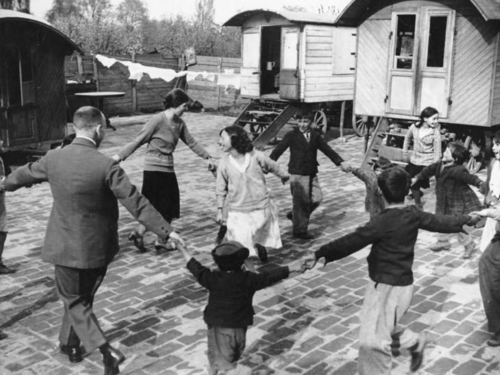
“Grossstad-Zigeuner focuses on the Romani people living in the Berlin districts of Wedding and Marzahn – Moholy-Nagy’s interest in Roma was already visible in his 1929 Marseille film, which contains a brief scene with a horse-drawn wagon and a bear. [...] However, in many instances clichés are transcended by the filmmaker’s honest and committed interest in people. Grossstadt-Zigeuner focuses on children (a recurring trope in humanist photography but also an important topic in Moholy-Nagy's other city films) and on the faces of individuals, many of them looking directly at the camera. As a result, the film has a spontaneous and intimate cinéma vérité feeling, which is also underscored by the use of jump cuts, and a mobile camera that even swirls among the dancing gypsies. Furthermore, Moholy's hand-held camera evokes the highly physical presence of the filmmaker among his subjects.”
Steven Jacobs1
“In April 1932, László Moholy-Nagy shot a number of rolls of 16 mm film stock over several days in the Berlin neighbourhoods of Wedding and Weissensee on the grounds of the encampments that were inhabited by Roma and Sinti at that time in Berlin. The film that was to result, Großstadtzigeuner/Urban Gypsies was screened publicly neither in Germany prior to Moholy-Nagy’s emigration in 1934, having been refused certification there, nor anywhere else in the world in the years that were to follow, prior to his death in 1946. This work, like all of the films made by Moholy-Nagy during his short career, were long inaccessible to the public having been withheld by Sibyl Moholy-Nagy until the late 1960.
Although being one of the few filmic records of Roma and Sinti life in Germany prior to 1933 and as such often being classified as an ethnographic work, it is not productive to view it as such. [...] The contextualization of Großstadtzigeuner within the filmic avant-garde of the 1920s and, more specifically, as an example of the Großstadtfilm (or ‘big city film’), offers a more productive perspective on the film. [...] We learn next to nothing about the self-consciousness or self-definition of the ‘urban Gypsies,’ we learn far more about their reaction to Moholy-Nagy’s (and his camera’s) presence among them. [...] In this sense the visible presence of the camera in Großstadtziguener points particularly to the presence of Moholy-Nagy. That he meets with the perhaps quintessential stranger in Europe, the Urban Gypsy, does not point to the fact that the ‘Gypsy’ of the film’s title is a representative of the romantic past but is rather a representative of the quintessential situation of the modern metropolis: we witness the presence of a stranger among strangers.”
Robin Curtis2
- 1Steven Jacobs, “Grossstadt-Zigeuner,” In: Steven Jacobs, Eva Hielscher and Anthony Kinik (eds.), The City Symphony Phenomenon: Cinema, Art, and Urban Modernity Between the Wars (New York: Routledge, 2019).
- 2Robin Curtis, “The Stranger in a City Filled With Strangers: Moholy-Nagy's Urban Gypsies,” Framework: The Journal of Cinema and Media (Cinematic Images of Romanies), 2(2003), 42-56.”

